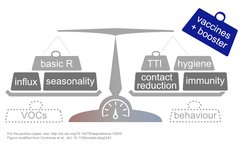Sustainable strategies against the COVID-19 pandemic in Germany in winter 2021/2022.
The research group of Viola Priesemann's at the Max Planck Institute for Dynamics and Self-Organization has coordinated a recent statement by leading international scientists on the occasion of possible strategies for pandemic response in winter. Provided below is the summary of the collaborative situation assessment; the link to the full statement can be found in the side menu.
Since July 2021, the delta variant of the SARS coronavirus-2 (SARS-CoV-2) has also been dominant in Germany. It is significantly more contagious than the previously known variants. This means a high risk of infection for the unvaccinated. In addition, without a third vaccination ("booster"), protection against the virus decreases continuously over time. After five months, protection against infection drops from a factor of about 10 to a factor of 2-3. As a result, not only the unvaccinated currently contribute to the spread of the virus, but also that part of the population that has been vaccinated for some time. Together with seasonality, this is reflected in a rapid increase in incidence.

The current situation is very critical since the exponentially increasing incidences are directly linked to the occupancy in intensive care units. In order to counteract permanent overcrowding in intensive care units, vaccination and the improvement of vaccination protection through third party vaccination in particular is effective in the long term. Vaccinations have two protective effects: They protect the vaccinated person from severe disease and protect those around them from transmission. Thus, with each improvement in vaccine protection, both the spread and the likelihood of a severe course are reduced. Boosting and closing vaccination gaps is therefore extremely helpful.
Currently, vaccines are available in sufficient quantities. New vaccines coming on the market, which are among the "classic" protein vaccines, could further support this, especially in people who are critical of the previous vaccines. Especially among those vaccinated first, i.e., those at increased risk of a severe course due to advanced age and underlying disease, protection is now significantly lower, and thus the burden on hospitals from this group will increase again. Rapid third vaccination of this fairly large group, as well as all those who have contacts with vulnerable individuals, significantly reduces the expected burden on the health care system.
However, a significant reduction in the dynamics of infection will only be achieved with the help of truly nationwide third-party vaccination. However, this will require a significant acceleration in the pace of third-strain vaccination: Since about 7% of the population has been second-vaccinated per week since the end of May, the same vaccination pace for third-vaccination 5-6 months later would now be possible and reasonable. Simulations show that a booster campaign at this vaccination rate will begin to have an impact after only one month.
Until a sufficient proportion of the population is boosted and vaccinated, the current situation also requires clear and effective measures to bridge the gap if ICUs are not to be severely overloaded. Here, the well-known AHA+LA rules, as well as consistently enforced and comprehensive rules and testing concepts in the work and leisure sectors, are important and helpful. Increased testing as a sole measure will probably not be sufficient to break the incipient winter wave. We describe the effectiveness of possible measures in detail in the text. However, these are only stop-gap measures, as they do not directly address the problem of too high a rate of spread, but instead leave it to "natural immunization" through infection. However, "natural immunization" progresses much more slowly than vaccination could, and is also associated with a significant disease burden. In this respect, rapid and comprehensive vaccination and boosting appears to be the most effective method to break the current wave soon and to control the pandemic in the long term.
